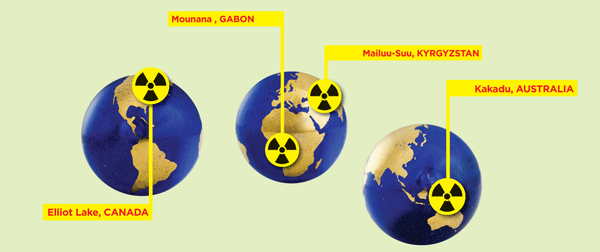Four uranium spills you may not have heard about
Elaisha StokesWebsite
Proponents argue that nuclear power is greener since it produces lower carbon emissions. But mining and refining the uranium that fuels reactors produces many toxic byproducts, including arsenic, thorium-230, and radioactive waste. Uranium is scarce too, which means that to produce one kilogram of uranium, you have to dig up and process one tonne of uranium ore, and more than 99 percent of that material ends up as radioactive waste. These “tailings” often end up in man-made ponds — but seldom stay there.
Unlike oil spills, which produce sensational images of oil-covered ducks, uranium tailings spills are under-reported and quietly insidious. Here are some of the stories you might have missed:
Elliott Lake, Canada
Spill: Accidental. In August of 1993 a power failure at the Rio Algom’s Stanleigh mine allowed uranium tailings to spill into McCabe Lake and contaminate the water source.
Contamination: Two million litres of tailings entered McCabe Lake.
Effects: Tailing spills had devastated 90 kilometres of the Serpent River by the late 1970s. The Serpent River First Nations indigenous territory is thoroughly contaminated with radioactive waste.
Punishment or resolution: The Atomic Energy Control Board of Canada charged Rio Algom with one count of failure to provide proper training for employees, and one count of failure to prevent a spill. The mine has been decommissioned.
Mailuu-Suu, Kyrgyzstan
Spill: Pending. Kyrgyzstan was one of the primary sources of uranium for the U.S.S.R.’s Cold War arms race. Two million tonnes of toxic waste sits in 23 open pits around Mailuu-Suu. The tailings sit atop a mountainous fault line, making a toxic disaster nearly inevitable.
Contamination: In 2005, a landslide caused 300,000 cubic metres of material to spill into the Mailuu-Suu river, dangerously close to one of the tailing piles. The Mailuu-Suu river connects to water sources for civilians in Kyrgyzstan, Uzbekistan and Tajikistan.
Effects: Over 23,000 people are at immediate risk of overexposure to radon, with a potential risk for millions. Some cancer rates in the area are twice as high as the national average.
Punishment or resolution: None. In 2008 The Kyrgyz government created a special agency to deal with the cleanup of the tailings with the help of NATO and the World Bank, but to date little progress has been made.
Mounana , Gabon
Spill: Intentional. During 40 years of uranium mining in this former colony, French nuclear giant Cogéma opted to dump radioactive tailings into Ngamaboungou creek, polluting Mounana’s water supply.
Contamination: More than two million tonnes of uranium tailings were disposed of in the Ngamaboungou river valley.
Effects: To date the only data on the impact of tailings disposal is from Cogéma itself, who claim there was no real impact. Cogéma calculated that area residents, however, are exposed nearly three times the international guidelines for occupational exposure.
Punishment or resolution: None.
Kakadu, Australia
Spill: Accidental, repetitive.
Contamination: Over the course of its lifetime, the Ranger uranium mine in Northern Australia has released over 2000 cubic metres of contaminated water into the wetland and waterways surrounding Kakadu National Park. A trucking accident near the mine earlier this year spilled 17,000 litres of sulphuric acid into the wetlands—the largest chemical spill in local history.
Effects: Uranium levels in the nearby Corridor Creek are now 4,000 times the recommended drinking water standard. One recent government study found cancer rates among the Aboriginal population in the Kakadu region are twice as high as those living elsewhere.
Punishment or resolution: Ineffective. The Ranger mine has been repeatedly fined for failing to meet standard regulations, between $82,500 and $150,000 per incident. But tailing breaches continue to occur.
